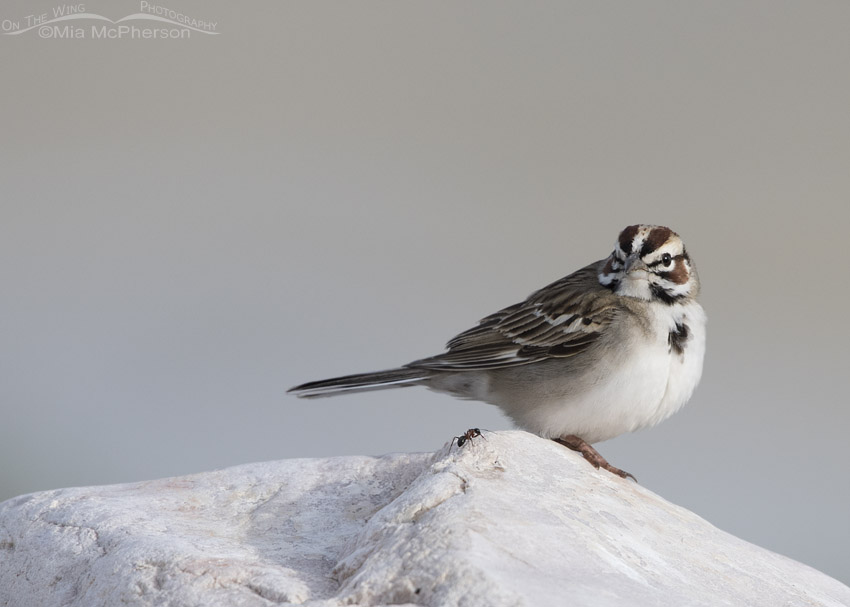 Lark Sparrow with an Ant – Nikon D810, f6.3, 1/1600, ISO 400, Nikkor 500mm VR with 1.4x TC, natural light
Lark Sparrow with an Ant – Nikon D810, f6.3, 1/1600, ISO 400, Nikkor 500mm VR with 1.4x TC, natural light
I have seen a few reports that Lark Sparrows are returning to northern Utah on the UBird group and I thought I saw one fly by me the last time I was on Antelope Island but it was such a quick look that I am not 100% sure that is what I saw.
I am very fond of Lark Sparrows because of their harlequin faces, their song and how early on in the breeding season they perch on top of rocks and sagebrush which allows me very nice views of these large sparrows. Lark Sparrows are only here for a few months a year and I hope that this year I will be able to add more photos of these sparrows to my portfolio.
Lark Sparrows are commonly seen west of the Mississippi but populations to the east are in decline due to reforestation and urbanization. They are another one of the bird species I quite often hear before I see them.
Listen to Lark sparrow singing here.
The day I photographed this Lark Sparrow with an ant on the boulder right next to it the light wasn’t the best for bird photography but when I reviewed the images and saw the ant I knew I had to keep this photo. I have images of Larks Sparrows with grasshoppers and caterpillars but this is the first one where I captured an ant in the frame with a Lark Sparrow. This isn’t my best photo of a Lark Sparrow but it is unique.
Antelope Island provides plenty of the habitat Lark Sparrows prefer on their breeding grounds and it is an excellent location to find, hear, observe and photograph this unmistakable and easily identified sparrow species.
Life is good.
Mia
Click here to see more of my Lark Sparrow photos plus facts and information about this species.


Beautiful shot Mia.
Thank you Bobby
Beautiful little bird (Chondestes grammacus) with a cheerful song isn’t the only lark of course. Wikipedia has this to say about larks:
Larks are passerine birds of the family Alaudidae. All species occur in the Old World, and in northern and eastern Australia. Only one, the horned lark (Eremophila alpestris) is also found in North America.
Love this image! BTW, 42 subspecies are recognized: https://en.m.wikipedia.org/wiki/Horned_lark#/search
Utahbooklover, this is a Lark Sparrow not a Horned Lark, they are true sparrows while the Horned Lark is a true lark. The name does get confusing though!
Thanks for clearing that up. I easily get off on a tangent sometimes.
My pleasure Utahbooklover, their names can easily be confused.
Yet more feathered enchantment.
Feathers do delight!
Great pic. The subtle background colors and contrasts you captured are amazing! Thx Mia
Thank you Pepe!
Just lovely. I’m firmly convinced that birds taught humans all about music and I’m so thankful they did. That said, I prefer listening to the originators of music more often than human interpretations So many species like white-crowned sparrows, canyon wrens, cardinals and so many others delight my soul. JOY!
So many species like white-crowned sparrows, canyon wrens, cardinals and so many others delight my soul. JOY!
Laura, nature and birds had to have taught humans all about music. I often prefer the music the bird make but I have to admit I love driving with my windows down and the music up loud (not too loud though).
That’s quite a shot! Love the song…an interesting mixture of beautiful, liquid notes and almost buzzing slurs…parts of its song tenpminds me of my grandmother’s canary, Willie Sing…..
Patty, they do remind me a canaries a little bit, I hadn’t thought of that. Thank you.
Love!
Thanks Kim